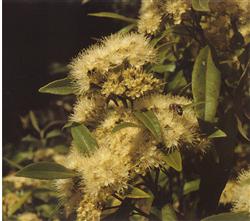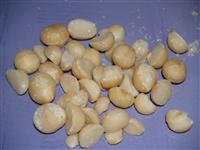Learn about identifying, growing and using Australian indigenous plants for food.

There are many Australian plants that are edible, and even some that are in very high demand as foods throughout the world. The Aborigines lived off the land before white civilization came to Australia. Plants contributed significantly to their diet.
There are many different types of bush tucker foods:
- Nuts and seeds (eg. Acacia, Macadamia, bunya nuts)
- Drinks (eg. hot teas, infusions of nectar laden flowers, fruit juices)
- Flavourings (eg. lemon scented myrtle)
- Berries (eg. Astroloma, some Solanum species)
- Fruits (eg. quandong, Ficus macrophylla, Syzygium)
- Vegetables
- Wattle seeds ground to produce ‘flour’
- Plant roots ground to produce a paste or flour.

Lesson Structure
There are 8 lessons in this course:
- Introduction
- Scope
- Is it Edible
- Native Plants to be Cautious with
- Understanding Plant Toxins
- Nutritional Value of Bush tucker
- Plant Identification
- Naming Plants
- Hybrids, Varieties and Cultivars
- Plant Families
- Pronouncing Plant Names
- Resources
- Growing
- Understanding Soil
- Improving Soil
- Feeding Plants
- Growing Australian Plants on Low Fertility Soils
- Planting Procedure
- Mulching
- Pruning Australian Plants
- Propagation
- Seed
- Collecting, Storing, Germinating Seed
- Difficult Seeds
- Seed Germination Techniques
- Handling and raising seedlings
- Asexual Propagation (Cuttings, Division, etc)
- Gathering
- Introduction
- Ethics
- Bush Foods as A Commercial Venture
- Gathering Acacia Seed
- Developing a Bush Food Garden
- Designing a Bush Garden
- Selected Native Trees for a Bush Tucker Garden
- Selected Shrubs for a Bush Tucker Garden
- Selected Small Indigenous Australian Plants for a Bush Tucker Garden
- Rainforest Gardens
- Desert Gardens
- Edible Arid Zone Bush Tucker plants
- Water Management
- Nuts and Seeds
- Macadamia
- Araucaria
- Aleurites moluccana
- Athertonia diversifolia (Atherton Oak)
- Castanospermum australe
- Hicksbeachia pinnatifolia
- Acacias
- Using Acacias (eg. Wattleseed Essense)
- Vegetables
- Native Spinach (Tetragonia tetragonioides)
- Pigface (Carpobrotus sp.)
- Longleaf Mat Rush (Lomandra longifolia)
- Solanums (Bush Tomatoes or Kangaroo Apple)
- Blechnum indicum
- Apium prostratum (Sea Celery)
- Native Lilies
- Microseris lanceolata (Yam Daisy)
- Dioscorea transversa (Wild Yams)
- Native ginger Alpinia caerulear
- Seaweeds
- Fruits
- Astroloma
- Austromyrtus dulcis (Midgen Berry)
- Billardiera sp (eg. Appleberry)
- Davidsonia purescens (Davidson’s Plum)
- Eugenia spp. and Syzygium spp. (eg. Bush Cherries)
- Ficus (Native Figs)
- Planchonella australis (Black Apple)
- Quandong (Santalum)
- Rubus sp (Native Raspberry)
- Other Fruits ...lots more outlined
- Flavourings, Teas, Essences
- Backhousia
- Curcuma (related to ginger)
- Eucalyptus
- Leptospermum
- Soaked Flowers (eg. Grevillea)
- Acacia
- Alpinia caerulea
- Tasmannia sp
- Using Bush Tucker Plants
- Develop your ability to identify, select, and develop processing procedures, for a range of varieties of bush food plants selected.
Each lesson culminates in an assignment which is submitted to the school, marked by the school's tutors and returned to you with any relevant suggestions, comments, and if necessary, extra reading.
Aims
- Discuss the nature and scope of bush tucker plants.
- Review the way bush tucker plants are accurately identified.
- Describe how to cultivate a range of bush tucker plants.
- Describe how bush foods are harvested from the wild and how to set up a cultivated bush food garden.
- Outline the cultivation, harvest and use of various bush tucker nuts and seeds.
- Explain the cultivation, harvest and use of various bush tucker vegetables
- Explain the cultivation, harvest and use of various bush tucker fruits
- Explain the cultivation, harvest and use of various bush tucker plants that are used to flavour foods or beverages
- Describe the preparation of bush tucker.
BUNYA NUTS
There are about 15 species of Araucaria mostly from tropical or subtropical areas of Australia, South America and the Pacific islands. Araucaria bidwilli (the Bunya) produces an edible nut that in the past was a prized food by some Australian aboriginals. It is a tall, erect tree to 40 m. Branch arrangement is very symmetrical; bark is rough and dark coloured. Leaves are stiff and whorled around stems. Cones are very large, 30cm x 20 cm. Seeds are edible. Natural distribution is coastal districts in Queensland. An imposing tree for coastal plantings, although care needs to be taken in choosing planting positions as the tree sheds prickly leaves and branchlets which can be a nuisance, and the large cones can be dangerous when they fall. It is frost hardy and moderately hardy to coastal conditions.
These are hardy, and tolerate moist soil and salt spray (they are particularly suited to coastal planting). They respond well to fertile soils and watering during dry periods. They are slow growing, but will survive in poor conditions. For the best shaped tree maintain terminal (top) growth. If the top dies, side shoots may develop in which case, the strongest should be retained and the others removed. The form of the tree may however suffer. If you like a lower bushier effect, Araucarias will often coppice if pollarded (no guarantee though). If a branch begins to die back, the whole branch is likely to eventually die; hence it is best to remove it back to the trunk.
Sucking insects such as scale and mealy bug can be a problem; and various diseases can occasionally arise including blight, cankers and crown gall.
Propagation is by seed but the seed should be fresh. Cuttings are not easy to strike, but if a cutting is struck from a branch, it is likely to grow outwards (horizontally) like a branch rather than taking on the form of a well-shaped upright tree.
This is a good bush tucker food; but commercial viability is limited for many reasons.
Some bush tucker is excellent to eat, but may be hard to get. Other bush tucker may be easier to get (grow or buy). Availability is increasing though, as interest in new and different types of foods grows.
People are always looking for the next big thing in food plants; and Australian Bush Tucker plkants offer a lot of possibilities in that respect.
WHY CHOOSE US?
• Reputation: well-known and respected in horticulture
• Industry focus: courses designed to suit industry needs and expectations
• Different focus: develop problem solving skills that make you stand out from others
• Hands on: develop practical as well as theoretical skills
• Lots of help: dedicated and knowledgeable tutors (Faculty of internationally renowned horticulturists)
• Efficient: prompt responses to your questions
• Reliable: established in 1979, independent school with a solid history
• Up to date: courses under constant review
• Resources: huge wealth of constantly developing intellectual property
• Value: courses compare very favourably on a cost per study hour basis
• Student amenities: online student room, bookshop, ebooks, acs garden online resources.